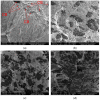Polylactide/Carbon Black Segregated Composites for 3D Printing of Conductive Products
- PMID: 36235970
- PMCID: PMC9573264
- DOI: 10.3390/polym14194022
Polylactide/Carbon Black Segregated Composites for 3D Printing of Conductive Products
Abstract
One of the most important directions in the development of additive manufacturing or three-dimensional (3D) printing technologies is the creation of functional materials, which allow not only prototyping but also the manufacturing of products with functional properties. In this paper, poly-lactide acid (PLA) /carbon black (CB) composites with segregated (ordered) structure have been created. Computer simulation based on the Mamunya geometrical model showed that the CB content within φ = 2.5-5 vol.% in the polylactide matrix leads to the formation of a continuous electrically conductive phase with an increase of electrical conductivity σdc above the percolation threshold. The simulation results were experimentally confirmed by optical microscopy and studies of the electrical conductivity of the composites. It was found that increasing CB content from φ = 1 vol.% to φ = 7 vol.% in the composites causes insignificant (due to the segregated structure) phase changes in the polylactide matrix and improves the thermal properties of composites. Electrically conductive filaments for Fused Deposition 3D Printing (FDM) were developed from PLA/CB composites and then 3D printed. A correlation between the electrical conductivity σdc and the CB content φ for base composites, filaments produced from them, and final 3D samples, has been found. Conductivity varies within σdc = 3.1·10-11 - 10·10-3 S/cm for the filaments and σdc = 3.6·10-11 - 8.1·10-4 S/cm for the final 3D-products.
Keywords: FDM 3D printing; electrical conductivity; morphology; poly (lactic acid)/carbon black composites; segregated structure; thermal behavior.
Conflict of interest statement
The authors declare no conflict of interest.
Figures


















References
-
- Narayan R., Yoo J., Atala A. 3D bioprinting: Physical and chemical processes. Appl. Phys. Rev. 2021;8:030401. doi: 10.1063/5.0060283. - DOI
-
- Lim L.-T., Auras R., Rubino M. Processing technologies for poly(lactic acid) Prog. Polym. Sci. 2008;33:820–852. doi: 10.1016/j.progpolymsci.2008.05.004. - DOI
-
- Sharma A., Rai A. Fused deposition modelling (FDM) based 3D and 4D Printing: A state of art review. Mater. Today Proc. 2022;62:367–372. doi: 10.1016/j.matpr.2022.03.679. - DOI
-
- Plastic in a Coil with Special Properties [Electronic Resource] [(accessed on 25 August 2022)]. Available online: https://pro3d.com.ua/g75852675-plastik-kotushtsi-spets.
LinkOut - more resources
Full Text Sources

